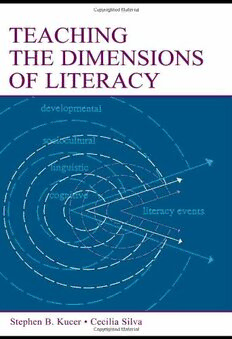
Teaching the Dimensions of Literacy PDF
425 Pages·2005·3.461 MB·English
Most books are stored in the elastic cloud where traffic is expensive. For this reason, we have a limit on daily download.
Preview Teaching the Dimensions of Literacy
Description:
Teaching the Dimensions of Literacy provides the conceptual knowledge to support teachers' instructional decisions in the reading/literacy classroom and features a multitude of instructional strategy lessons for classroom use with both monolingual and bilingual students. Its premise is that literacy comprises four dimensions--linguistic, cognitive, sociocultural, and developmental. In the debate over literacy instruction, and in many reading/literacy methods texts, one dimension tends to be privileged and the others ignored. In this text, the teaching and learning of all four dimensions of literacy are acknowledged and addressed. The four dimensions provide a coherent conceptual framework within which instructional strategy lessons are identified, synthesized, organized, and presented--demonstrating how the complex nature of literacy can be addressed within a classroom setting. *Part I introduces the conceptual framework for teaching and learning the dimensions of literacy. These chapters reflect the authors' belief that literacy instruction involves more than passively following and implementing a series of recipes, but rather, is a conscious, reflective, and constructive process whereby teachers enact instruction based on their knowledge of their discipline. In an age of standardized curricula and tests, more than ever teachers are needed who are capable of taking on responsibility for promoting literacy learning of their students. This requires a deep understanding of what reading and writing entail linguistically, cognitively, socioculturally, and developmentally. Part I helps teachers acquire this understanding. *Part II presents the instructional strategies. The book is structured so that teachers who are required to implement a particular literacy program can select strategy lessons to supplement their curricula. For teachers who develop their own programs the strategy lessons provide a base from which to do so. The instructional strategy lessons provide various avenues though which to teach the particular literacy dimension on which the chapter is focused. All strategy lessons are formatted the same way: concept, materials, procedures, variations, sample instructional materials. Each lesson can stand on its own. Teachers can select those activities they find most appropriate for their own instructional context. The strategy lessons can be easily modified as required by the needs of the teacher and students. *Part III illustrates what a dimensional literacy curriculum might look like in the classroom, helping teachers to organize strategy lesson instruction within a logical framework. Teaching the Dimensions of Literacy can be used as a primary or supplementary text for pre-service and in-service elementary reading, literacy, and language arts methods courses. The user friendly format makes this text particularly appealing as a resource teachers will want to purchase and use independently of any university course.
See more
The list of books you might like
Most books are stored in the elastic cloud where traffic is expensive. For this reason, we have a limit on daily download.
